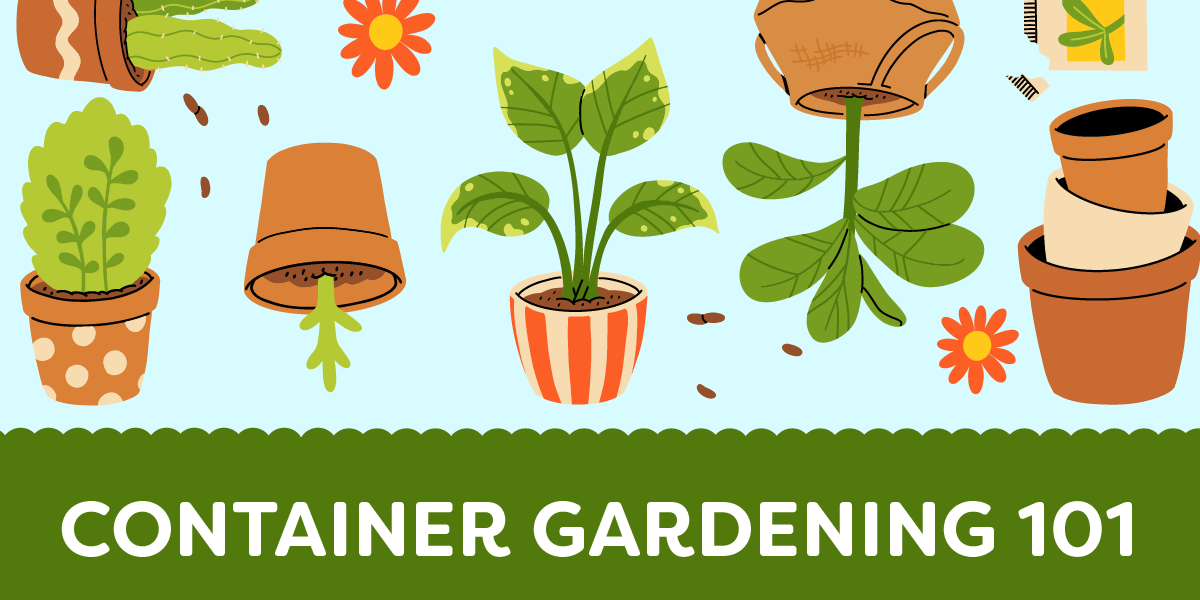Is your balcony as bare as a hospital hallway?
Perhaps it’s time to spruce things up — and what better way than with flowering plants?
A few well-chosen plants can transform your space into a relaxing retreat and most-favored destination for pollinating critters.
Even the tiniest balcony, porch, or patio has room for a potted plant or two, or three, or four…

A balcony transformed by potted plants.
Why Container Gardening?
Container gardening lets you exercise your green thumb in an area the size of a tabletop. Tomatoes, vining flowers, and dwarf trees flourish in containers, but in this blog, we’ll focus on flowering plants.
Here’s why container gardening is such an attractive option for apartment dwellers, homeowners with small yards, or gardeners looking to extend the growing season:
- Flexibility: Move your plants to catch the best sunlight and escape extreme temperatures, or rearrange your layout for a fresh look.
- Control: Manage soil quality, watering schedules, and pest control more effectively.
- Accessibility: Enjoy gardening regardless of mobility issues or access to yard space.
- Beauty: Enhance a drab space with the color, texture, and fragrance of flowering plants.
The Essentials of Container Gardening
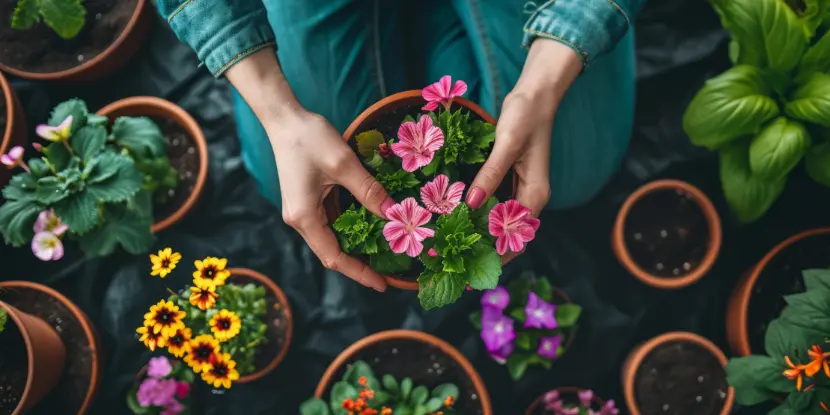
A woman potting flowers for her container garden.
Picking the Right Container
- The pot should be large enough to accommodate an expanding root system.
- Select the best material for the task. Terracotta, plastic, ceramic, and metal all have pros and cons. Terracotta breathes but allows the soil to dry quickly, while plastic retains moisture.
- Proper drainage is critical to prevent root rot. Pots must have adequate drainage holes.
- Consider the container’s weight in case you need to move it.
Choosing the Right Soil
Potted plants rely on the gardener for all their nutrients, starting with soil.
- Don’t use garden soil; it’s too dense and may contain weed seeds or disease organisms.
- Purchase a quality potting mix that includes peat moss, vermiculite, perlite, and compost.
- Consider adding slow-release fertilizer to the soil or incorporating organic fertilizers into your watering routine.
Watering Wisdom
Overwatering and underwatering are common mistakes. A good rule of thumb is to water when the top inch of soil feels dry, but this can vary based on plant type, weather, and pot material.
Fertilizing Container Plants
- Choose a balanced, water-soluble fertilizer or a slow-release granular fertilizer designed for flowering plants. Look for formulations with an N-P-K ratio that suits your plant’s needs.
- Always follow the manufacturer’s directions. Over-fertilizing can be just as harmful as under-fertilizing.
- For liquid fertilizers, mix the recommended amount with water and apply it during your regular watering schedule, generally every two to four weeks. For slow-release fertilizers, sprinkle the granules on the soil surface according to the package instructions, usually every three to four months.
- Watch your plants for signs of nutrient deficiencies, such as yellowing leaves or stunted growth. Adjust your fertilizing routine based on plant health and the growing season.
- Periodically flush the soil with plain water to wash out any built-up salts from fertilizers. This helps prevent root burn and maintain healthy soil conditions.
- Reduce or stop fertilizing during the dormant season, usually in winter.

An outdoor seating area complemented by flowering plants.
Best Flowering Plants for Pots & Planters
Ready to start planting? Here are some of the best flowering plants for containers:
1. Petunias
Petunias are famous for their trumpet-shaped flowers that bloom all summer long. They prefer full sun and regular watering, so ensure your containers have good drainage.
- Light: Full sun
- Water: Moderate; let the soil dry out slightly between waterings
- Special Tip: Deadhead spent blooms to encourage more flowers
2. Geraniums
Geraniums come in a wide variety of colors and are known for their hardy nature. They do best in full sun to partial shade and require well-drained soil.
- Light: Full sun to partial shade
- Water: Moderate; let the soil dry out slightly between waterings
- Special Tip: Pinch off wilted flowers to promote more blooms

Potted geraniums for sale. Who’s buying?
3. Impatiens
Impatiens are perfect for shady spots, bringing bright colors to areas where other plants might struggle. They bloom continuously with minimal care.
- Light: Partial to full shade
- Water: Frequent, keep the soil consistently moist
- Special Tip: Avoid getting water on the leaves to prevent disease
4. Marigolds
Marigolds are easy to grow and a top choice for beginners. They’re known for their bright, sunny colors and pest-repellent properties.
- Light: Full sun
- Water: Moderate; let the soil dry out slightly between waterings
- Special Tip: Deadhead spent blooms regularly for more flowers
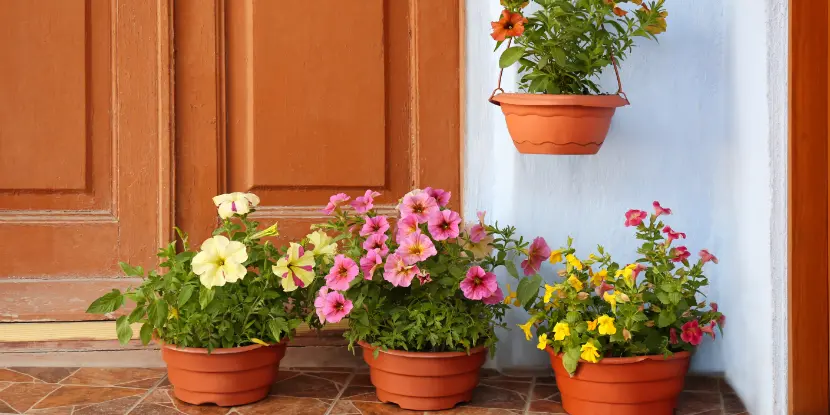
Potted flowers enlivening a front porch.
5. Salvia
Salvia is a low-maintenance plant that produces beautiful tall spikes of blue, purple, or red flowers. It prefers full sun and well-drained soil.
- Light: Full sun
- Water: Moderate; let the soil dry out slightly between waterings
- Special Tip: Prune back in late summer to promote new growth and blooming in the fall.
6. Lavender
Lavender is exceptionally fragrant and can be used in various ways, from cooking to crafting. It thrives in containers with well-drained soil.
- Light: Full sun
- Water: Allow soil to dry out between waterings
- Special Tip: Prune after blooming to maintain shape and promote growth
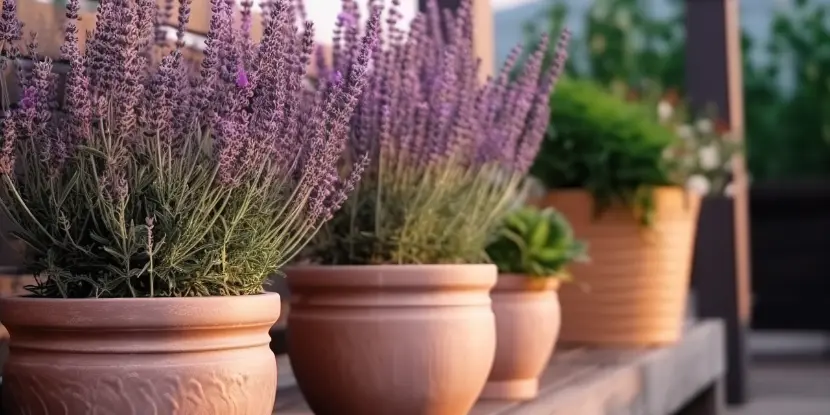
Potted lavender plants on a porch bench.
7. Fuchsias
Fuchsias are distinguished by their brilliant, drooping flowers, which hummingbirds can’t resist. They do well in hanging baskets and prefer cooler, shadier spots.
- Light: Partial shade
- Water: Keep soil consistently moist
- Special Tip: Protect from harsh afternoon sun to prevent leaf burn
8. Begonias
Begonias, with their striking rosette blooms, are highly adaptable. They thrive in partial shade and can tolerate a range of soil types as long as they’re well-drained.
- Light: Partial shade
- Water: Keep soil evenly moist but not soggy
- Special Tip: Remove dead leaves and flowers to encourage new growth
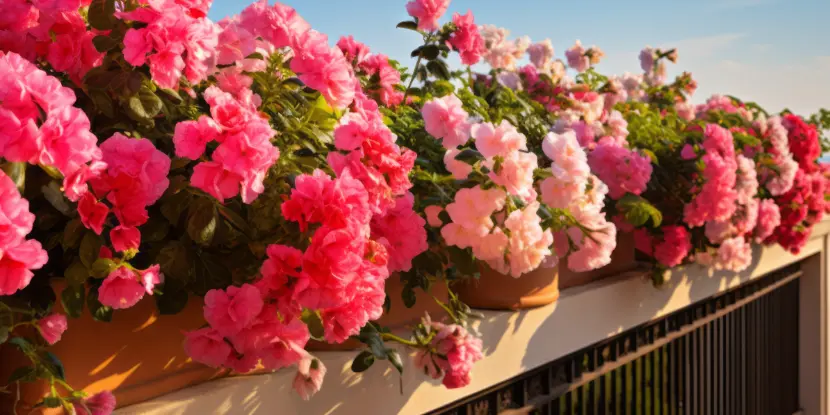
Container-grown flowers on the railing of a porch.
9. Nasturtiums
Nasturtiums are beautiful and edible. They can grow in poor soil, making them an excellent choice for less attentive gardeners.
- Light: Full sun to partial shade
- Water: Moderate; let the soil dry out slightly between waterings
- Special Tip: Harvest leaves and flowers for culinary use; they add a peppery flavor to dishes
10. Pansies
Pansies are cool-weather plants producing bright, cheerful blooms in early spring and fall.
- Light: Full sun to partial shade
- Water: Regular, keep the soil consistently moist
- Special Tip: Remove spent blooms to encourage continuous flowering

Bright pansies with their friendly “faces.”
11. Lantanas
These drought-tolerant plants flourish in California’s warm, sunny climate. Their tiny, fragrant flowers attract butterflies.
- Light: Full sun
- Water: Low to moderate; let the soil dry out between waterings
- Special Tip: Prune regularly to maintain shape and promote new blooms
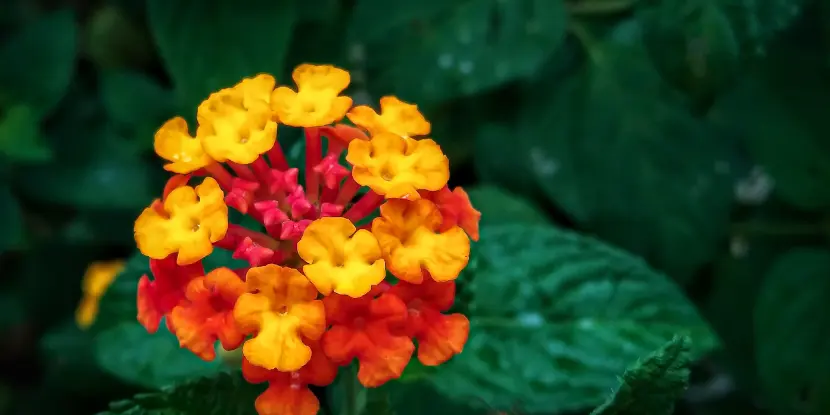
The tiny, delicate flowers of a latana plant.
12. Zinnias
Zinnias are bright, bold flowers that bloom all summer. They’re exceptionally easy to grow in containers, prefer well-drained soil, and are heat-tolerant.
- Light: Full sun
- Water: Moderate; allow the soil to dry out slightly between waterings
- Special Tip: Deadhead regularly to extend the blooming period
13. Calibrachoas (Million Bells)
Calibrachoas, often called Million Bells, offer abundant small, petunia-like flowers that bloom profusely throughout the season.
- Light: Full sun
- Water: Moderate; keep the soil consistently moist but not waterlogged
- Special Tip: Incorporate liquid fertilizer into the watering routine for robust growth
Creating Eye-Catching Arrangements
It’s not enough to grow the flowers — you’ll also want to organize them in the most appealing display. Professional florists carefully design their bouquets, and a container flower garden should follow similar principles
Here are some tips to get you started:
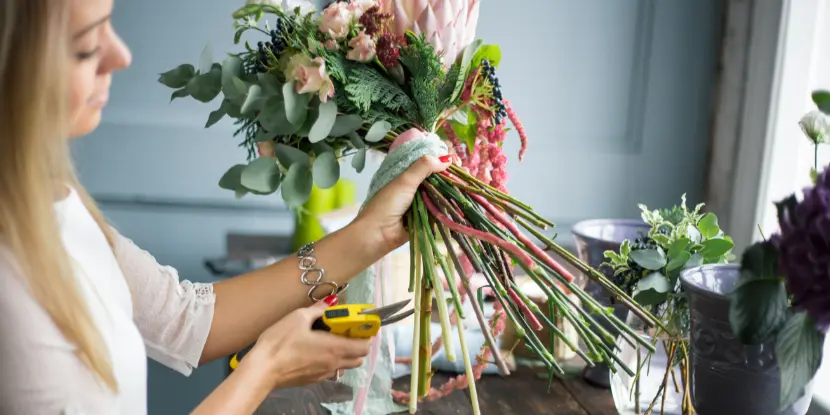
A home gardener prepares flowers for a vase arrangement.
The Thriller, Filler, Spiller Technique
This classic arrangement involves three types of plants:
- Thriller: A tall, eye-catching plant in the center (e.g., Dracaena)
- Filler: Medium-height plants to add fullness (e.g., Petunias, Geraniums)
- Spiller: Trailing plants that spill over the edges (e.g., Ivy, Sweet Potato Vine)
Color Harmony
A harmonious color scheme pairs flowers that complement each other while creating a unified look.
- Monochromatic: Different shades of one color (e.g., shades of purple using Salvia, Lavender, and Heuchera).
- Analogous: Colours next to each other on the color wheel (e.g., red, orange, and yellow using Marigolds, Nasturtiums, and Zinnias).
- Complementary: Colours opposite each other on the color wheel (e.g., purple and yellow using Lavender and Marigolds).
- Triadic: Three colors evenly spaced around the color wheel (e.g., red, yellow, and blue using Geraniums, Marigolds, and Lobelia).
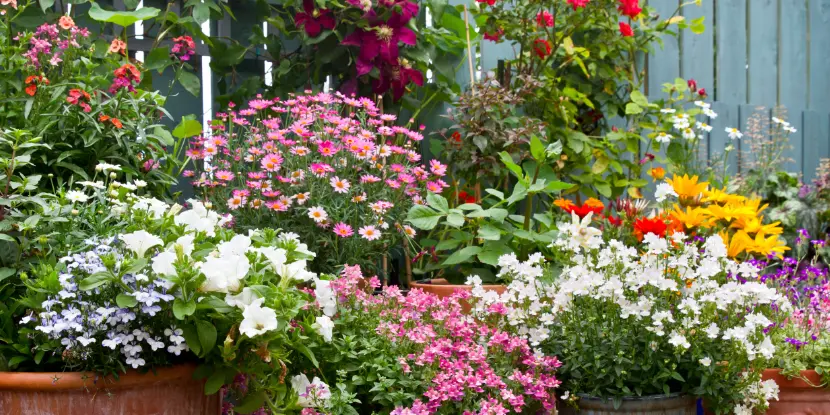
A beautifully tiered garden of container-grown flowers.
Height Varieties
To create depth and visual interest, place taller plants at the back or center, medium-height plants in the middle, and trailing plants around the edges.
- Tall: Asparagus fern, cannas, sunflowers
- Medium: Begonias, geraniums, Lantanas
- Low: Calibrachoas, pansies, nasturtiums
Foliage Focus
Remember the impact foliage can have on your container garden.
- Bold foliage: Coleus, hostas, elephant ears
- Variegated leaves: Ivy, polka-dot plant, spider plant
- Texture: Lamb’s ear, artemisia, Dusty Miller
Seasonal Switch-Ups
Refresh your containers by swapping out plants to suit the season:
- Spring: Use tulips, daffodils, pansies
- Summer: Opt for geraniums, marigolds, petunias
- Autumn: Add mums, ornamental kale, asters
- Winter: Include pansies, cyclamen, Christmas cacti
Conclusion
Whether you’re a seasoned gardener or just starting, container gardening offers endless possibilities for creativity and joy.
So grab some pots, pick your plants, and let your green thumb work magic!
Need additional guidance? Please visit your local Anawalt garden center for more ideas.
FAQs: Growing a Container Flower Garden
Q: Can I use any type of soil for container gardening?
It’s best to use a high-quality potting mix rather than garden soil. Potting mix is lightweight and well-draining, which is ideal for containers.
Q: How often should I water my container plants?
This depends on the plant type, weather, and container material. Generally, water when the top inch of soil feels dry. In hot weather, you might need to water daily.
Q: Can I leave my containers outside during the winter?
Some containers can withstand freezing temperatures, but many plants cannot. Bring sensitive plants indoors or protect them during winter.
Q: How do I prevent pests in my container garden?
Regularly check your plants for signs of pests. Remove dead leaves and debris, avoid overwatering, and consider using natural pest repellents like neem oil.
Q: What are the best plants for beginners?
Marigolds, geraniums, and petunias are well-suited for beginners due to their hardiness and low maintenance needs.
Q: How do I choose the right container size for my plants?
Choose a container with enough space for the plant’s root system to grow. Generally, small plants need a pot at least 6-8 inches in diameter, while larger plants require containers 12 inches or more in diameter.
Q: Can I reuse potting soil from last year?
Potting soil can be reused, but it should be refreshed. Remove old roots and debris, and mix in fresh potting soil or compost to replenish nutrients. Adding perlite or vermiculite can improve soil structure.
Q: What should I do if my plants are not blooming?
Ensure your plants receive optimal light and water and get the proper nutrients. Pruning spent blooms and deadheading can also encourage new growth and more flowers.
Q: Is it necessary to provide drainage holes in my containers?
Yes, drainage holes are essential to prevent water from accumulating at the bottom of the container, which can lead to root rot. If your container doesn’t have drainage holes, consider drilling some or placing a layer of gravel at the bottom to improve drainage.

